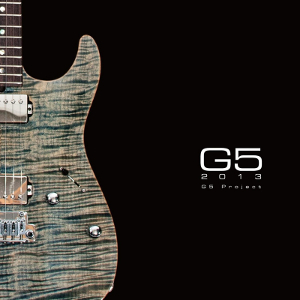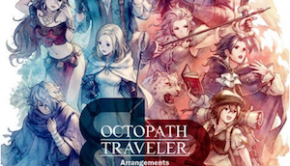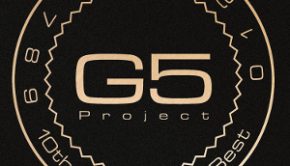G5 2013
 |
Album Title: G5 2013 |
| Record Label: G5 Project |
|
| Catalog No.: GFPR-2013 |
|
| Release Date: December 31, 2013 |
|
| Purchase: Buy at Bandcamp |
Overview
G5 2013 is an original album released under Masahiro Aoki’s ViViX label featuring guitar compositions from the G5 Project, which is a series of artists that include Masahiro Aoki (as his alias Godspeed), a2c (of MintJam), Nike, Takajii, and YAMATO. What sorts of styles can we expect on this album and is it worth a purchase?
Body
The album opens up with “Dying to survive,” by Yamato, the G5 Project’s newest member whose previous performer credits can be found on the Twilight Sky Atelier Escha & Logy -Alchemist of Dusk Sky- Vocal Album and it really sets the album off on a fantastic start. It’s an extremely powerful guitar tune full of post-hardcore metal riffs, some keyboard synth, and even some soft choir accents towards the end of the track. Of course, the focus of the piece is the guitar and Yamato really manages to show off his skill, both as a guitarist and composer, despite being the youngest member of G5, with a powerful melody and some amazing solos. “Emergency,” by Nike, is another impressive tune that mixes some electronic elements, particularly in the intro and outro, with a solid guitar piece reminiscent of something one might hear in a j-rock, or even visual kei, band. It boasts an extremely memorable “chorus” with chugging percussion and some great guitar solos. However, while the majority of the piece is quite fast paced, there is a nice slow instrumental bridge with some distortion that really manages to add a nice musical texture to the entire piece.
Moving from the heavier pieces, we have “Kamuy,” by a2c, of Mintjam, with a symphonic rock piece. Featuring setsat on violin and chiemi on the chorus, the piece itself is still quite moving with its stunning melody. However, despite this, there is definitely a heavy metal feel to the riffs that complement the orchestral components of the piece quite nicely. This is definitely one of the highlights on an incredibly strong album thanks to the strong performance and composition. Takajii offers two very different pieces on the album. The first, “Flounder,” manages to combine a variety of styles including some funk rock, flamenco, and a bit of piano jazz into something that is extremely cohesive and rich with atmosphere. Not only is the composition strong, but the solos are some of the best on the album. I find myself jamming out to this quite a bit and it is by far my favorite track on the album. His other tune, “Fragile Seasons,” is more along the lines of a rock ballad. It’s an extremely beautiful tune that really manages to convey tons of emotion thanks to the twangy guitar line, the piano, and strings. It’s a nice way to mellow out an album that is full of heavy tunes. I could definitely seeing this being used as an ending theme to a game or anime and would make a great backing tune for the addition of vocals as well.
Of course, Masahiro Aoki contributes two tunes on the album as well. “Virus” features a djent rock approach. In some ways, it reminds me of the sort of rock music that was popular in the 90s by bands like Soundgarden. There are lots of powerful riffs mixed with wailing guitar lines that make for quite a spectacle. There is also some electronic elements added near the end of the piece, lending for a bit more of a chaotic sound. While I don’t think this addition was particularly necessary, it doesn’t take away from the piece either. The last piece on the album, “Journey,” by Masahiro Aoki, John Graham, and Koyo Sonae is more of a cinematic rock piece that features beautiful orchestral tones with a softer focus on guitar. That’s not to say that there isn’t any spectacular solos, as there are, but the orchestral backing definitely takes the forefront of the piece and makes the guitar piece seem more of a support instrument rather than the shining star.
Summary
In the end, G5 2013 is an extremely well-produced album featuring a variety of rock styles that is sure to please anyone who is a fan of electric guitar. All the artists manage to highlight the guitar and show they are great composers as well. Although it is only 7 tracks long, it is well worth the admission price, especially if you purchase the digital copy available through most digital outlets worldwide. If you have been a fan of Masahiro Aoki/Godspeed’s work in the past, this is certainly not an album to miss either, as the other members of the G5 Project really manage to impress as well.
Do you agree with the review and score? Let us know in the comments below!
4.5
Posted on May 31, 2014 by Don Kotowski. Last modified on June 16, 2014.















Err, I thought Godspeed’s track Virus was more of a djent-ish approach with experimental lead guitar. Not melodic rock.
Thanks Dhooparty. I am not familiar with all styles of rock, but I updated the review to reflect the djent style. Still think there is a prominent melody, even if it isn’t quite melodic rock in style.
I think the lead melody is much more prominent compared to other songs in the djent genre. That may be why it seems more like melodic rock. Most djent I have heard has sparing amounts of melodic lead playing.
There is also one more thing you might want to add, about YAMATO’s piece; Specifically, the song is not exactly heavy metal, but post-hardcore with a bit of progressive influence. Not sure if you’re familiar with it, but hardcore is basically heavy metal taken to the very extremes, using darker and heavier riffs and more agressive and fast drumming often accompanied by screaming vocals, with a general less emphasis on melody. Post-hardcore is essentially the same but utilises more of a darker and melancholic melody style with diminished scales and chords. I think the riffing style in the piece is based upon post-hardcore music, while the lead playing is more progressive.
Not a big deal or anything, but there is a significant difference between heavy metal and hardcore. I’m sure there might be some obnoxious persons who will stumble upon this great review sometime and post hate comments, so I’d reccommend editing it, but do whatever you like.